Tajikistan Adventure!Even though I historically, am not the type to go on any sort of guided hunt, I happened into one on the other side of our world this past month.
Almost a year ago, Pierre (Joe Perry) gave me a call that he had bought a Siberian Ibex hunt at a "Wild Sheep Foundation" banquet and there was a opening for another hunter to join him and wanted to know if I'd like to go. Well after checking costs out and seeing if this thing would be doable for me I said what the heck, I'm not going to live forever so better start doing a few things outside my norm.
So after a few phone calls to see what the hunt was all about and what was expected of me, I started planning a possible hunt of a lifetime. Pierre had other commitments until the end of January, so we had to take the late hunt slot. We knew that the weather and conditions might be harsh, but expected the worst and hoped for the best.
I told, my good friend Tjones that I had decided to go on a hunt in Tajikistan, and that we'd be driving over 300 miles of the trip on the boarder of Afghanistan with just a river between us and ISIS, or Taliban fighters. He told me a Ibex was not worth getting my head removed on video. The river as it turns out is one violent raging torrent. There had been some Americans killed in August on the same road we were driving by ISIS but those were bikers that were using social media to document their trip across the country on the "Silk Hwy".
This trip takes 31 hours from my door of constant travel to get to the destination of our village that we would hunt out of.
The hunt was with H&CAT, (Hunting and Conservation Alliance of Tajikistan). A Community based hunting and game management area there. The idea was to give locals a vested interest and monetary gain from thriving wildlife they share. So now this Ibex herd has grown from 40 over 10 years ago to what they tell me is 700. They watch the animals and protect them from possible poachers. The group I hunted with are all locals, some have the distinction of being called "Rangers". Everyone from our drivers, to our interpreters lived along our route. They get half the hunt money for the local village, while others are paid directly from H&CAT for other services to get us there and put us up, feed us, etc.
The language we encountered was Russian with a Persian dialect to it. Kinda crazy but they teach English to their children, and after taking care of our needs the adults from our Village went to night school to learn English. Deb Perry (Joe's wife Deb is retired teacher) actually went and taught a few classes while we were there.
The trip down the "Silk Road" was not a smooth one, very rugged and took twelve of the hours spent to get there. After beating down this road and almost to our destination we encountered the first of many avalanches in the area and had to turn back to the town of Rushon for the night. They put us up in a guest house with no heat (5*) for the night and next morning we headed back to the avalanche to port over to another vehicle waiting on the other side.
The photo's below, are the description of what a community based conservation means. Some of the avalanches we ported over, the village and residence we stayed at. More later.Attachments
Snowing like Billy Hell here, so I'll try another paragraph or two on the Tajikistan adventure.
My wife was about to kill me after 5 hours on this supposed hwy. During my conversations with the guys that do the logistics for this trip they told me that we would drive about 5 hours and then they would put us up in a place that had a hot springs spa, for a day or two to acclimate. Now, I'm not sure they took my words completely literal or not, but I told them that I had hot springs in Montana, and didn't really need to acclimate there and would rather hunt than soak. I said maybe a day, but not two. So my wife expected to be whisked away to a spa and got twelve hours of the road from hell instead. Disclosure: (I told my wife up front that this could be a very tough trip when I asked if she wanted to come. I told her that the road trip could last anywhere from 12 to 24 hours depending on which conservation area they would send us.)
The mountain range we were hunting in is called the Pamirs mountains. They range up 20,000 ft elevation, and much of that range is around 14,000 to 16,000 ft. The village sits at a little over 7,100 ft so the mountains stretch straight up for 7 to 13,000 ft depending on which one you'er on.
After the collapse of the soviet union, Tajikistan fell into a civil war. It lasted 5 years with the no clear victor. The old hard line Soviet backed regime aided by tanks and air power helped them keep power, but they had to hand over many of the duties to the opposition in negotiating a lasting piece. The country is half the land mass of Montana, but has 8 million people living there. The average age is under or around 30 if memory serves me. There were anywhere from 20,000 to 100,000 killed in that civil war, many of the relatives of the people we know there lost family. The region we hunted in was where the uprising began, and today is heavily armed. The region has lots of army check points we had to pass through. This is the main reason we paid a little extra money up front for VIP treatment. These people from H&CAT met us at the airport, took us through customs with our weapons, and then got us swiftly through every check point along the way. I know of horror stories that were told of tourist going through these check points without guides, and lost money, electronics, and passports. We sailed through all this with no problems at all.
In a country that has an annual income is around $100 US, $230 is a lot, but that's a cheap fee for no hassles, and smooth sailing in that part of the world. The Soldiers we encountered did not look to be very well equipped, and many didn't have any weapons.Some stations looked pretty lonely along the Afghan boarder. I didn't take any pictures of the soldiers as I didn't want to provoke them. Maybe next time. The drivers vehicles were trashed on our drive, so I'm thinking they were rentals. They beat the living hell out of them.
Ok, back to the Hunt.
After our port over the last avalanche we finished up the drive to our village we ate a meal of dried fruits,nuts, a stew of undisclosed meat, (looked like goat as the ribs were quite small.) tea, and their very own squeezed cherry juice.(They put up all their own foods and everywhere you can grow a tree they have some sort of fruit tree planted. They are very self sufficient as there aren't many food stores there out of the main population centers). We got a good nights sleep, and after breakfast the crew was waiting outside to head up to hunting camp. The road from our village was covered with a lot of snow, and many avalanches along it's path. Normally they would drive you in, but this late in the season with unseasonably amounts of snow and cold, we would hike in the 8 miles.
Joe, is 65 years old, and if you don't know, he's a big guy. He had been living at sea level for past 2 months prior to our hunt and he was told there would be horses to haul him into camp. The disclosure that the horse had died didn't sit well with Joe, but he was determined to give'er a try to march in.
The first 3 miles of the hike has quite a steep elevation gain, and at around that point Joes hips were hurting him. Air was thin for a guy that had been living at sea level also. After a quick assessment of the situation the Rangers decided that Joe would stay back at the Village until the Cat could clear the road into camp. So back Joe went, and that might of been a very good thing as his health got worse the next few days.
Not more than a quarter mile after Joe's departure we witnessed a Snow Leopard on an Ibex that it had just killed. I never got the pictures (yet) but at some point they are suppose to send them to me. As we continued on at the half way point we stopped for lunch. There's a hut there built out of rock (everything's built out of rock there) that we sat in. After a little tea and Noon (their bread), the rangers suddenly started talking excitedly as they glassed the mountain. Up above us not more than 400 yards of snowfield was a group of Ibex and one very dark and large bodied animal. They all wanted me to get my gun up and take aim. I slowed down the situation a bit and took a look through the spotter. Now I studied some pictures of Ibex before the hunt, and had been told what to expect so I didn't think that this first Ibex was THE Ibex. I asked how large the Ranger thought he was. He said 10 years old. I shook my head, no, not old, how many centimeters? He said maybe 100 or so. I told him that I wanted 100 plus the distance from my thumb to the end of my little finger with my hand opened up. Even drew a picture in the snow. I told him that unless the Ibex was that large, I wasn't shooting one on the first half day of my hunt. So to the chagrin of my group of Rangers I passed on the first Billy we saw. After glassing a few more bands of Ibex along the way we made base camp. It consisted of a rock building with wood thatched roof, and a dirt floor. The heat was two little wood stoves that burnt trimmings from the fruit trees or willows in the Creek bottom. The beds consisted of a shelf raised off the floor with straw under a tarp. I had a zero sleeping bag with me, and a insulated sleep pad, so all was good. I never got to cold even though the nights were around zero, and the only heat we had was the wood that was allowed to burn to send us off to sleep.
The next day we headed up above camp and glassed what I thought was a larger Ibex up near the top of the mountain. We only got a quick look and they didn't think he was any bigger than the dark one we saw the day before. We saw 5 Billy's on this mountain, and it didn't look to me to be as steep as the other areas we hunted. I said I would be willing to start the next day heading up that mountain but the Rangers wanted us to go down to look over a few drainage's that fed into the main canyon. Down near the mouth of one such canyon we spied another Billy. He looked like the others but my head Ranger said he was much older, and was worth going after if the other scouts came back empty.
The two rangers headed over to port the river, one ranger waded the river, then took his boots off and threw them back to the other Ranger waiting on the other side. It wasn't pretty but they made it across with out having lost the rubber boots and preceded up the canyon.
These guys wore some very dated rubber boots. Mainly looked like the type of boot we would put on to cross a wet field to change pipes or the type our kids wear out playing in the mud. Not mountain type boots at all. Their clothes consisted of old military pants and coats.
Jack Acheson (the hunting consultants where we bought the hunts) tried to get a hold of Joe and myself before we got to Bozemen to take a load of Sitka gear to the Rangers. I was already in Bozemen and Joe couldn't get linked up with Jack so our crew never got the gifts from Sitka. I guess a shipment worth $30,000 of Sitka gear got there after our hunt.
We hunted down towards the hut at the half way point and that's when we saw Snow Leopard#2. He was hunting the same group of Ibex that the large dark Ibex billy lived in. This made my Ranger very nervous. Got more pictures as we watched the Ibex climb the unclimbable cliffs that lurked above snowfields and on up into the clouds above.
We met back up with the other rangers who had not been successful in finding any Ibex of age. My Ranger liked the Ibex that we had glassed from there and so we made a plan to come back the next day and try for him.
The oldest Ranger (53) was called Gullbeck, and arguably was in the best shape of the rest of the crew. All were in better shape than I was. I hunted lions all Dec. and January as much as possible, but I'm not one to go to the gym. They walk everywhere and are very thin. Most people in the country are thin and in shape. You notice how fat Americans are after such a place.
Here's some more pictures.
Ibex in a scope,
Joe and my wife eating lunch at our Village house.
A Ranger in our hunting camp with a Partridge of some sort he caught. They are vicious little fighters and they use them in that fashion. Like Chicken fights in Mexico.
Joe and 3 Rangers heading outAttachments
Here's the base camp, and the halfway hut we spotted the Dark Ibex from.Attachments
Day 3
We headed back down, the Valley looking to find the "Much Older" Ibex from the day before. We got to the spot we had glassed him from the day before and set up the spotter. Gullbeck was looking up towards the the top of the open snow slide and said he spied the "Much Older" Billy. I looked through my 9 power Mavens and only saw a Nannie and a kid. I told Gullbeck I saw no billy up there and actually made the statement that I was thinking I was going blind then I said something about you'd have to be crazy to think a Ibex was there. I was the crazy one.
After spending the time I did with these guys I can tell you they are phenomenal at spotting game. In landscape that's snow and rock you wouldn't think finding a Ibex would be too tough, but I'm here to tell you straight up that's not the case. You will be humbled by their spotting prowess. Now I thought Old Gullbeck was looking through a monocular the whole time, and maybe that's what he preferred to use. After getting a little closer to him and looking over what he was using I was astonished to to see that it wasn't a monocular at all but what was once a 10 power Vortex bino that had been broken in half. Gullbeck was amazing with half a bino.
I took a quick reading on the mountain that our "Much Older" Ibex was living on and he was farther than my 1000 yard range finder could produce. actually at least twice as far, because I got 1000 yard readings less than half the way to him. The last cover going up the mountain was 400 yards up so we would be in line of sight from there on. As I understood it there was no was get over from another draw and get to him. I'm sure these guys had done many stalks in those mountains. I told them I didn't have the capability to shoot anywhere near the range we would be looking at. At that point they decided lunch was in order again, and promptly threw his coat down in the snow for me to sit on. Nice gesture by him, but I promptly let him know that's not taking place, and I'll stand or sit on a rock but I won't sit on his coat when he might need it dry later on. I was told after the my hunt that they had never been with a hunter like me before. Ask Tjones, and he'll probably confirm this on many fronts.
While dinning on the usual fruits, nuts, and Tea, one of the Rangers spies a Ibex down canyon about 4 miles. All the Rangers are very excited and as usual it's a much older Ibex than what we've found before. I'm thinking we are up to a 15 year Ibex by now. So we gather up lunch and head down canyon. We get down to where the Snow Leopard had been stalking the Ibex the day before, that's where we glass up the much older Ibex. He's near the rocky outcropped cliffs, and soon the Rangers come up with a plan for a stalk. I can tell you right up front that their route was not one I'd of come up with but it's their deal and so when in Rome do as the Romans do or tell you to do. I was to go with old Gullbeck on our stalk. He asked for my rifle, and I told him that the day I can't carry my own rifle is the day I hang er up. Of course everything has to be translated as Older Gullbeck speaks very little English. I say Older Gullbeck because the lead Ranger (36) is named Gullbeck too. So Old Gulleck and Old me head straight up the open snow field three draws up canyon of the feeding Ibex billy. The snow is about 2' deep here and I soon find out the open snow fields are really snow covered scree or larger rock fields mixed with maybe some areas of sparse vegetation.
We climbed maybe 1000 feet elevation and crossed over one vertical rocky pressure ridge from where I used my range finder to see how close we needed for a shot. The last of three pressure ridges we needed to get too was at my range finders max. It looked like I could shoot from there if everything we well and it didn't get dark on us. So we dropped down off the rocks and climbed another 1000 ft up above pressure ridge number two. My now burning lungs, and shaking legs were feeling the elevation as well as the tough terrain encountered at that elevation, coupled with what is now around 3' deep snow. We couldn't get across the pressure ridge without dropping our elevation again, nor could be climb higher as it was a boxed cliff. I told Gullbeck we need to go straight at the Ibex even though we would be in direct view of them there. Time was running out and we needed to get much closer. So luck was on my side here and all the Ibex were feeding away from us. Good in that they were not facing our way, bad in that they were now getting farther and higher up the mountain.
Gulbeck, hunkering down his little frame to not be seen hurried across the open area, with me, not really hunkering down my much larger and tired frame, just trying not to cause a avalanche. we got out of sight of the Ibex and Gullbeck looked at me and again said "I take your rifle". Now, for those of you who happened to remember what it was like to reach down deep when totally exhausted, in maybe the fourth quarter of a really tough football game, or find enough to finish that last minute of your wrestling match can understand what it was like at that moment for me. Gullbeck was given my rifle. I did the unthinkable for me and handed it too him so I could continue on. Exhausted and with shaking legs, I climbed another 1000 feet to the last of the pressure ridges. It took all I had to climb up the rocks to the top of that ridge where Gullbeck had cleared the snow off a perch at shoulder height to shoot from. To my total disappointment when I got there the Ibex was now standing at 568 yards and moving farther up the ridge. I don't shoot long range gear. I'm a Elk hunter and figure If I can't get within 400 yrds then I don't deserve the animal. It was getting dark, we had put a ton of effort into getting as close as possible on this stalk and I had spent myself completely. So I did what most would do and started to figure out my bullets trajectory at that range.
I know my .280 very well, and it's reasonably a flat shooter. The max point blank range on the rifle is a tad over 280 yards. So I'm like a couple of inches low and 300, 14 at 400 and then around 30 at 500. Any farther is no mans land for me. I was thinking around 42" drop at the Ibex's range of 570 yrds. I shoot a fixed 6 power scope with a duplex that gets thick 6.5 inches per hundred yards under the cross hair portion of the scope. at 600 yrds that would make it 39" low there, so I used that to calculate my drop.
I have to be honest here. I had made up one box of bullets for this hunt, and then was told that I might need another box. I had a bunch of primed brass sitting upright in the garage that had been there a while. I took those filled them with powder and topped them off the day before we left. When we got to our Village I checked the zero and took three bullets from my first box to check where I was hitting. One shot and she was perfectly on line almost three high. When I headed up the mountain, the Ranger packing my backpack had my bullets and I took out 7 from the second box thumbed 5 in the mag and two in my left pocket, and only one left of two in my right pocket. Must of put the other one back in and left only one.
I lined up on the Ibex giving him all my duplex plus about 3 more inches and squeezed off. CLICK goes the bolt, I couldn't believe it, I bolted that round out, slammed in another. CLICK goes the bolt again. I couldn't believe it. All five bullets in the magazine did the same thing again.
Half way around the world, on a hunt of a lifetime, and my bullets are failing me, never in my life had I had a bullet not go boom. Never!
While Gullbeck was packing my rifle he inadvertently had brushed it full of snow, He thought that maybe the bolt had froze up and so had me take it out and heated it with his lighter. I showed him the primers and the pin had dented them so I knew the gun was working just not the bullets.
I re ran every one of those through the gun again, swearing, and cussing, words I'm sure Gullbeck had never heard in English before, maybe any language. Then just as my heart was ready to leave my body and die right there I remembered the one round left in my right pocket. As I put that bullet in, one of the Nannies made a sound and the Billy came down to see what the excitement was about. Not sure if she saw us, but considering the comedy that took place on the cliff at 11,000 feet maybe she wanted him to see the idiot American hunter trying to kill him. I don't know what it was other than maybe God feeling sorry for me right then and there, but the Ibex billy came down to just about 534 yrds give or take. He was close to 600 at last reading so 60 + yards closer was good news. I put that bullet in said a prayer and BOOM goes my gun. Gullbeck said "Gun go Boom" I said yes, He said" Whop" goes bullet. I said yes, and we might have Ibex maybe. He looks through his half bino, and says "Maybe".
The hike up to the Ibex wasn't quite as painful as before, I had an Ibex laying above me. We got there I took one "As they lay" picture and Gulleck grabbed him up and headed down the slide. The other rangers were heading up the mountain and it was getting dark fast. We got together about half way up the mountain and that's where the hero shots were recorded. By the time we had drug the Ibex to the bottom it was totally dark and we were 4 miles from either the village or the hunting camp.
1st photo, Rangers porting river with one set of rubber boots
2nd phot The canyon they went up scouting for me.
3rd How they lay
4th photo Elvation shot of 11,000 feet, with the three pressure ridges we stalked over and under and around. Shot from closest one.
5th photo Hero shot with Ibex and Rangers.Attachments
Not quite done yet.
So with the Ibex dragged down to the bottom of the mountain in the dark, I had agreed to show the "Rangers" how to cape animals for American taxidermists. There was an issue with a hunter from Alaska that took a great Ibex but his cape job wasn't to good. The lips were short and the ears not turned, and eyes not skinned properly. So I gutted the Ibex, Rooter style, then did the preliminary cuts on the cape up too the head. Before I could do the rest the head Ranger says lets take the rest down to Village and you can finish there in the daylight. They wanted to hang the meat in the only tree around to keep wolves away, but Leopards could still get to it. I figured we'd go back to the Village but they wanted me to go to the camp for the night. So off we go back to camp leaving behind two Rangers to hang meat and take head and cape to the village.
Next day same as always they feed me, eggs, fruits, and nuts. Some candies from Russia, and of course tea.( I'll comment on this for just a moment. I sweat a lot as a old guy now. Drinking little tea cups of tea are great, but I was constantly dehydrated from not ingesting enough water. Finally I told them just bring me big bottles of water from now on.) Then after breakfast we head up the valley to look for more Ibex. I guess I could have shot another one, but told them that one was enough, and didn't need another unless they had one that was substantially larger than what I took. From what I saw, I'd say that the one I took, same one I passed on first day, was as big as they had in that Valley. So after we headed back to camp for lunch I asked if they had heard if Joe was heading our way or not. They told me that some people from the upper village came through and said that a bull dozer had cleared the road about 600 meters above the lower village. I told the lead ranger that I was heading down to see what Joe wanted to do. I knew we still had a week left he wanted to hunt something else or try and make it up there. We had been watching a large group of Ibex right from camp with two nice Ibex Billy's and they came with in rifle range on a couple of days while I was there. If Joe could get to camp he would have a good chance at one of those Billy's. So down the valley I head with the lead ranger. When we get to where I gutted the Ibex we find that the snow leopard had cleaned up the guts, and tried to get at the meat hanging. 4 rangers had come and took everything to the lower village. At that point we meet the dozer. It was working on one of the largest avalanche sites but had cleared the road to that point. It looked promising to me that Joe could make it in now to hunt. Just before we got back to the village with the good news we find where another avalanche had slid across the road again. It wasn't giant but still too much for a jeep to get through. When we got to the village the lead ranger put together a work party of villagers and everyone took a shovel. They literally worked into the night to shovel the road out so the vehicle could drive up the valley. The next day I see many a villager with bandaged hands going about their daily chores. These people were unbelievable in how far they would go for us. Joe was past ready to get on the mountain and so up he goes. He hoped his wife Deb could go, but I didn't think that was too good an idea considering the next 6 miles are still snow packed with just our trail to get there. So off Joe went. I will let him tell his part of the hunt as it wasn't my kill.
I was treated to some outstanding food back at the village. My wife, and Joe's were still suffering from symptoms of altitude sickness, and possibly flu. Our hostess was also the town nurse and offered to give shots if they wanted.
Twice a day our hostess along with the other woman made their way to the river to haul water. they packed what looked like 5 gallons at a time. They also had a spring creek where they filled up bottles of water from drinking. They packaged my Ibex, and had already done the cape job. All I could do was hope they had left enough lips, eyes and turned the ears. As it turned out (pun intended) they had not turned the lips, or ears, but had salted the cape. They had processed the head by boiling it and separating the horns from the skull. This was needed so I could take the trophy back with me is a duffel bag that I planned on purchasing in Dushanbe.
Our hostess wore her head covered the whole time we were there and she told my wife that she was morning the death of her father and would wear it for a year after his death. The house we stayed at was his and it was handed down to her. Her husband had added two bedrooms and a small bathroom with gravity fed water for your shower. I took one very cold shower there, but that was because 4 and a half days of hunting and my wife said that I'd be sleeping with the cows or goats if I didn't shower.
1st picture is wife in our room at village
2nd is a meal of undisclosed meat with Noon bread and rice.
3rd Their religion is Sunni Islam and the four beams going up like this with light is some sort of religious symbol.
4th is our hostess and village nurse. She attends English class each night.Attachments
s
I will remember nightly walks to this little gem.Attachments
Joe's writing:Robert has outlined our hunt very well. He explained that I had been at sea level for over a month, home for 4 days, then off to Tajikistan. I had altitude sickness right away...never had it before. No stamina, no wind, lower back pain, hip pain, diarrhea, dizziness, head ache, no appetite, sleepy, etc. It was horrible. I was taking pills to help my blood attach more oxygen but our host's home remedy tea was as good as any. After laying around for several days, I finally felt some better and they plowed part of the road. I hiked in with little trouble. I would get dizzy but a short stop to allow more Oxygen to my brain would clear things up for a ways.It was in fact, a hunt of a lifetime. These conservation area hunts are valuable from several standpoints. The Rangers keep track of critters, protect them from poaching, and help with the hunts. They have brought the Ibex in these areas back from the brink of disappearing. The villages get about half of the price of the hunt. The terrain is unforgiving as is the altitude. Tough hunt. The cultural experience was great. Service was exceptional under the circumstances.I did bring a number of leatherman, knives, and other gifts for the village folks. I gave Old Gulbeck a brand new set of binoculars to replace his monocular (busted binocs). Deb planned on hunting with me but got a bit of altitude sickness too and never did. She did act as teacher for the villagers learning English at nite school. She had great fun with the villagers and our host family.
We did see some Ibex on the way in. Robert had done a lot of glassing and had noticed a particular Ibex that tended to move lower midday then back up. We found that Ibex high in the rocks. He was the biggest we could find. He actually moved down far enough that I was able to anchor him with one shot from my trusty 30.06. We'll get more pics posted.
This hunt is a fine life experience but age and physical conditioning is imperative. Give yourself plenty of time to acclimate. Check back for pics soon.
Joeere's Joes Ibex. Well deserved considering all he went through to get him.
My two week unshaven face. Wife said I looked like I could be a petifile.
Another avalanche.Attachments
Monday, March 25, 2019
Tajikistan Ibex Adventure
We don't often send something like this out but had a lot of requests. Robert Wood writes most of it. Joe and Debby Perry add some.
Subscribe to:
Post Comments (Atom)

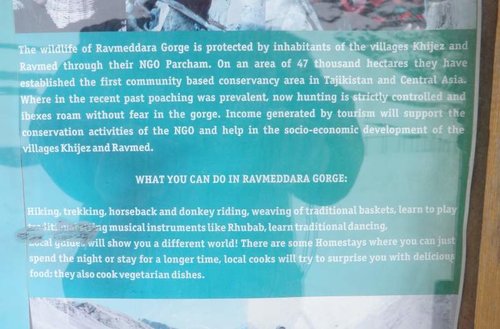
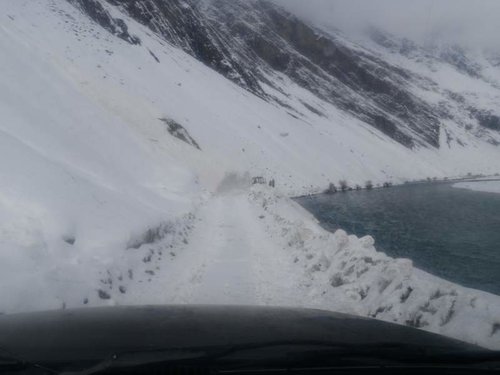
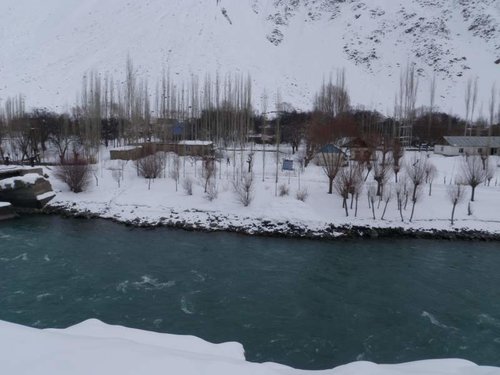
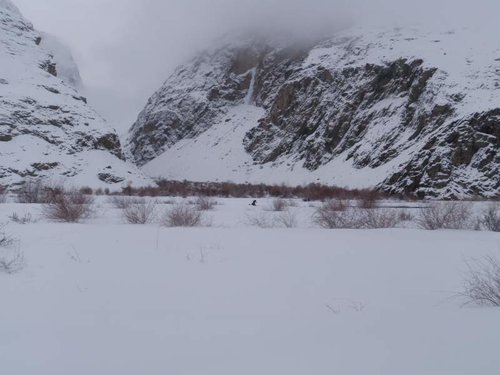
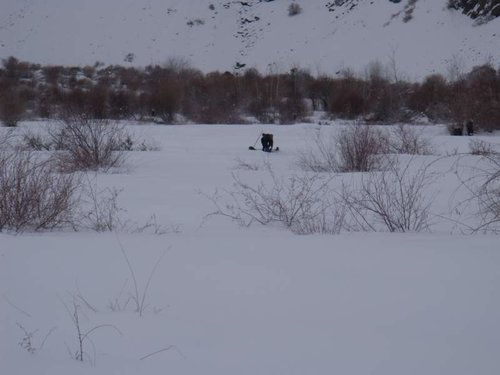
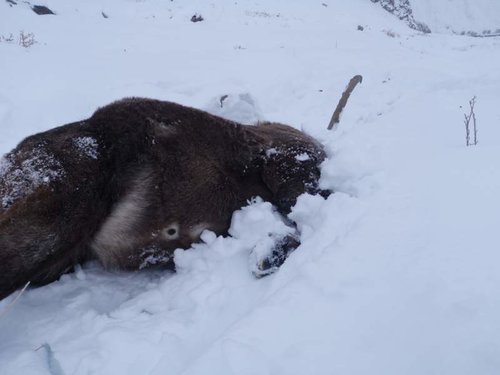
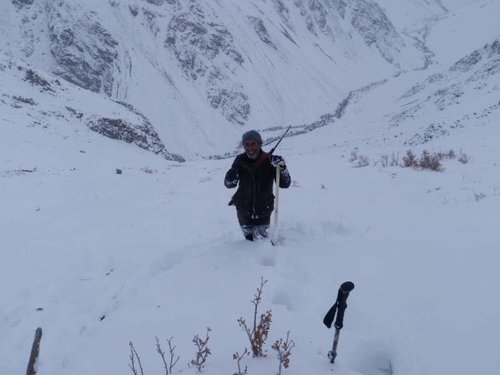
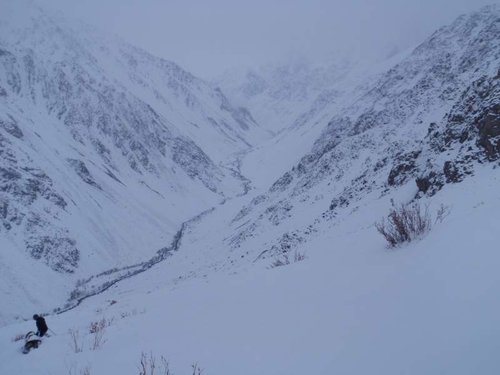
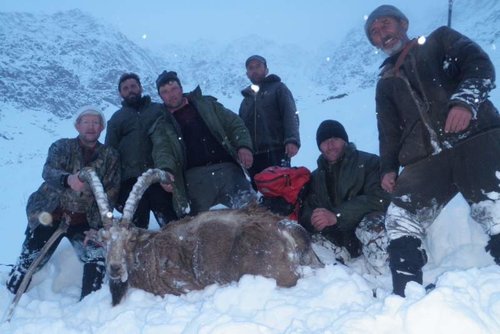
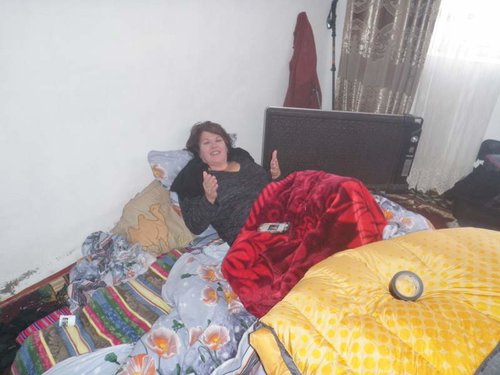
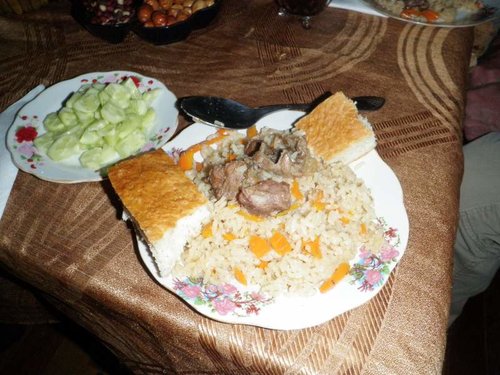
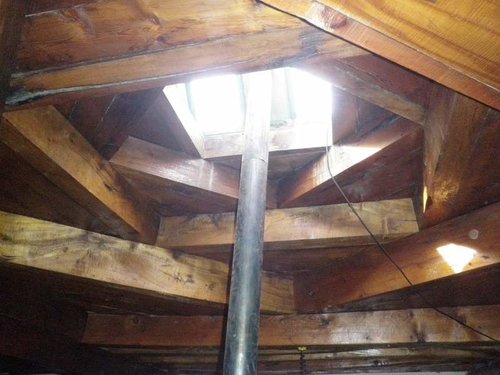
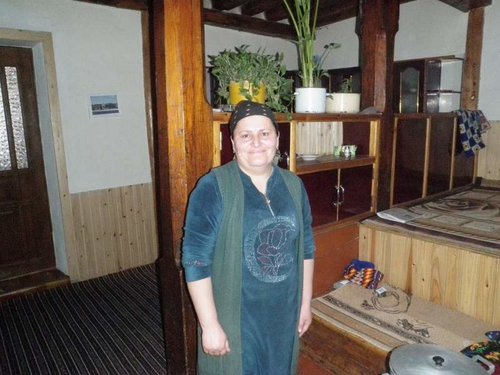
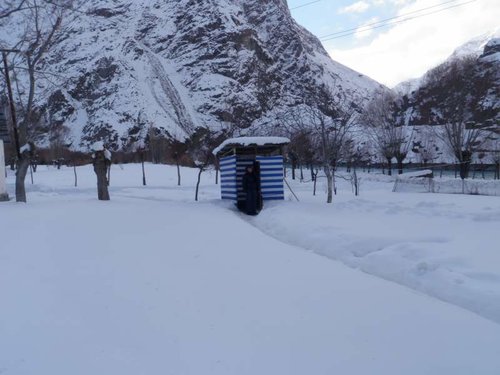
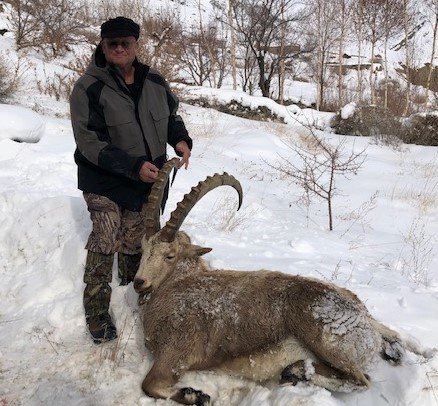
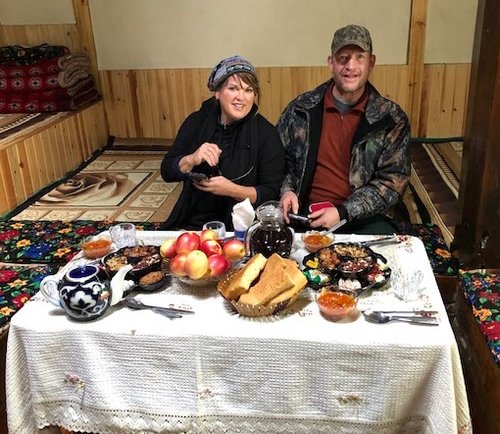
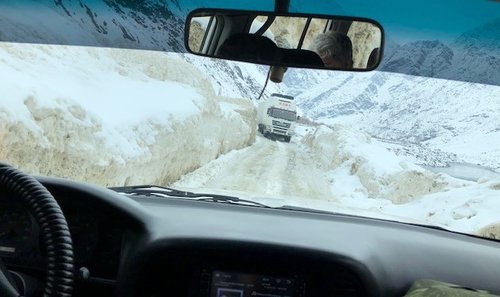
No comments:
Post a Comment